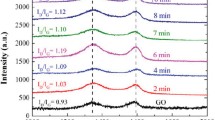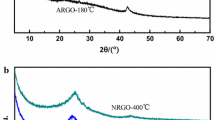Abstract
The conductivity of thermally reduced graphene oxide (GO) measured at various reduction stages shows that the samples demonstrate transition to the conducting state within a narrow range of annealing temperatures (150-170 °С). The conductivity in this temperature region increases by about five orders of magnitude to indicate that the percolation mechanism is responsible for this transition. According to this mechanism, the above temperature range is associated with formation of a certain number of conductive channels composed of GO fragments reduced to the conducting state. Thus, it is a new type of percolation transition, since increased conductivity is a result of increased conductivity of the particles due to thermal treatment rather than a result of increased concentration of conducting particles. A further temperature growth is associated with increased number of conducting GO fragments and the number of conducting channels, and some smoother conductivity increase. The XPS spectra of partially reduced GO samples indicate correlation between increased conductivity of GO fragments and plasmon oscillations revealed as XPS peaks. The current-voltage characteristics measured for the samples of partially reduced GO indicate a non-ohmic conductivity which manifests as increased conductivity versus voltage dependence. This is due to the fact that electrical resistance of the percolation channels is the sum of resistances of conductive GO fragments and contact resistances which depend on the voltage drop at the contact and, therefore, on the voltage applied.
Similar content being viewed by others
References
G. I. Titelman, V. Gelman, S. Bron, R. L. Khalfin, Y. Cohen, and H. Bianco–Peled. Carbon, 2005, 43, 641.
K. Yin, H Li., Y. Xia., H. Bi., J. Sun, Z. Liu, and L. Sun. Nano–Micro Lett., 2011, 51, 3.
S. H. Huh. Thermal reduction of graphene oxide. In: Physics and Applications of Graphene Experiments. S. Mikhailov (Ed.), chapter 5, InTech, 2011.
H. K. Jeong, Y. P. Lee, M. H. Jin, E. S. Kim, J. J. Bae, and Y. H. Lee. Chem. Phys. Lett., 2009, 470, 255.
J. Tu, N. Choi, C. Park, and H. Kim. Chem. Mater., 2015, 27, 7362.
Y. M. Shulga, V. M. Martynenko, V. E. Muradyan, S. A. Baskakov, V. A. Smirnov, and G. L. Gutsev. J. Chem. Phys., 2010, 287, 498.
P. V. Kumar, N. M. Bardhan, S. Tongay, J. Wu, A. M. Belcher, and J.C. Grossman. Nat. Chem., 2014, 6, 151.
А. V. Eletskii, А. А. Knighnik, B. V. Potapkin, and J. M. Kenny. Usp. Fiz. Nauk, 2015, 185(3), 225.
W. S. Hummers and R. E. Offeman. J. Am. Chem. Soc., 1958, 80, 1339.
V. P. Afanas′ev, A. S. Gryazev, D. S. Efremenko, and P. S. Kaplya. Vacuum, 2017, 136, 14.
G. S. Bocharov, A. V. Eletskii, and A. A. Knighnik. Tech. Phys., 2016, 86(10), 64–68.
G. S. Bocharov, A. V. Eletskii, A. A. Knighnik, and B. V. Potapkin. In: “Synthesis, structures and properties of metal/superconductor containing nanostructured composites” [in Russian]. L. I. Trachtenberg and M. Ya. Mel′nikov (Eds.). Moscow. Technosphere, 2016, 54–84.
L. D. Landau and E. M. Lifshitz. Quantum Mechanics. Non Relativistic Theory. M.: Moscow. 1989.
G. Eda, Y. Y. Lin, C. Mattevi, H. Yamaguchi, H. A. Chen, I. S. Chen, C. W. Chen, and M. Chhowalla. Adv Mater., 2010, 22(4), 505.
Author information
Authors and Affiliations
Corresponding author
Additional information
Original Russian Text © 2018 G. S. Bocharov, A. V. Eletskii.
Translated from Zhurnal Strukturnoi Khimii, Vol. 59, No. 4, pp. 841–849, May-June, 2018.
Rights and permissions
About this article
Cite this article
Bocharov, G.S., Eletskii, A.V. Percolation Transition Under Thermal Reduction of Graphene Oxide. J Struct Chem 59, 806–814 (2018). https://doi.org/10.1134/S0022476618040091
Received:
Published:
Issue Date:
DOI: https://doi.org/10.1134/S0022476618040091




